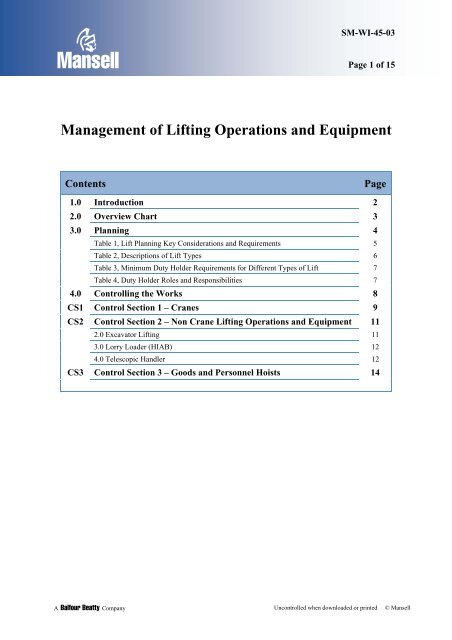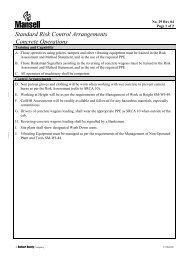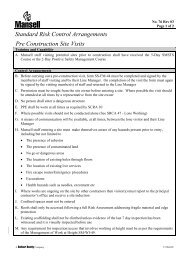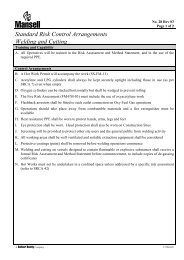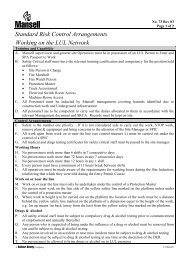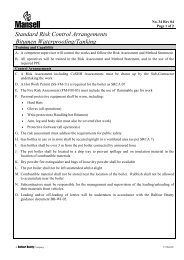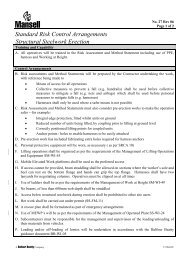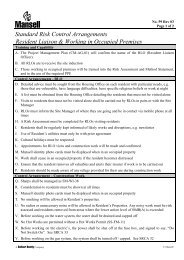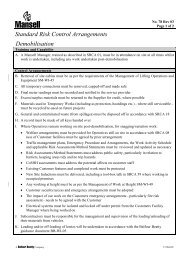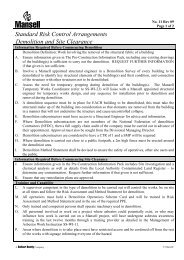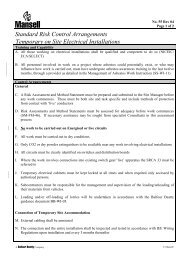Management of Lifting Operations and Equipment - to return to the ...
Management of Lifting Operations and Equipment - to return to the ...
Management of Lifting Operations and Equipment - to return to the ...
Create successful ePaper yourself
Turn your PDF publications into a flip-book with our unique Google optimized e-Paper software.
a<br />
SM-WI-45-03<br />
Page 1 <strong>of</strong> 15<br />
<strong>Management</strong> <strong>of</strong> <strong>Lifting</strong> <strong>Operations</strong> <strong>and</strong> <strong>Equipment</strong><br />
Contents<br />
Page<br />
1.0 Introduction 2<br />
2.0 Overview Chart 3<br />
3.0 Planning 4<br />
Table 1, Lift Planning Key Considerations <strong>and</strong> Requirements 5<br />
Table 2, Descriptions <strong>of</strong> Lift Types 6<br />
Table 3, Minimum Duty Holder Requirements for Different Types <strong>of</strong> Lift 7<br />
Table 4, Duty Holder Roles <strong>and</strong> Responsibilities 7<br />
4.0 Controlling <strong>the</strong> Works 8<br />
CS1 Control Section 1 – Cranes 9<br />
CS2 Control Section 2 – Non Crane <strong>Lifting</strong> <strong>Operations</strong> <strong>and</strong> <strong>Equipment</strong> 11<br />
2.0 Excava<strong>to</strong>r <strong>Lifting</strong> 11<br />
3.0 Lorry Loader (HIAB) 12<br />
4.0 Telescopic H<strong>and</strong>ler 12<br />
CS3 Control Section 3 – Goods <strong>and</strong> Personnel Hoists 14<br />
A Balfour Bea~y Company Uncontrolled when downloaded or printed © Mansell
a<br />
<strong>Management</strong> <strong>of</strong> <strong>Lifting</strong> <strong>Operations</strong> <strong>and</strong> <strong>Equipment</strong><br />
1.0 Introduction<br />
SM-WI-45-03<br />
Page 2 <strong>of</strong> 15<br />
1.1 <strong>Lifting</strong> equipment is any equipment used at work for lifting or lowering loads. This<br />
includes; cranes, fork lift trucks, teleh<strong>and</strong>lers, excava<strong>to</strong>rs used for lifting, lorry loaders<br />
(HIABs), personnel hoists <strong>and</strong> goods hoists. The definition also includes lifting<br />
accessories such as chains, slings <strong>and</strong> eyebolts etc. This document reflects <strong>the</strong><br />
requirements <strong>of</strong>; <strong>the</strong> <strong>Lifting</strong> <strong>Operations</strong> <strong>and</strong> <strong>Lifting</strong> <strong>Equipment</strong> Regulations 1998<br />
(LOLER), <strong>the</strong> British St<strong>and</strong>ard ‘Safe Use <strong>of</strong> Cranes’, BS7121 <strong>and</strong> <strong>the</strong> British St<strong>and</strong>ard<br />
‘Safe Use <strong>of</strong> Construction Hoists’, BS7212.<br />
1.2 This document does not detail requirements for <strong>to</strong>wer cranes. For those refer <strong>to</strong> <strong>the</strong><br />
Balfour Beatty document ‘Manual for Tower Crane Procurement <strong>and</strong> Operation’, BB-<br />
WI-04. This document does not detail requirements for cranes on barges as <strong>the</strong>se are<br />
<strong>the</strong> subject <strong>of</strong> separate regulations.<br />
1.3 Incidents that occur involving cranes or lifting equipment are very serious, costly <strong>and</strong><br />
<strong>of</strong>ten fatal. On average <strong>the</strong>re are 17 fatalities each year resulting from lifting<br />
operations. It is important <strong>to</strong> plan, resource <strong>and</strong> organise all lifting operations<br />
properly so that <strong>the</strong>y are carried out in a safe manner.<br />
1.4 This document has been produced <strong>to</strong> assist project teams manage risks associated with<br />
<strong>the</strong> use <strong>of</strong> lifting equipment through effective planning <strong>and</strong> control measures. This<br />
will reduce <strong>the</strong> potential for injuries caused during lifting operations.<br />
1.5 Viewing <strong>and</strong> Navigating:<br />
• Navigate this document using <strong>the</strong> bookmark icon in <strong>the</strong> left h<strong>and</strong> margin<br />
• Sections 2.0 <strong>to</strong> 4.0 <strong>of</strong> <strong>the</strong> document set out <strong>the</strong> general principles, requirements<br />
<strong>and</strong> thought process <strong>to</strong> be applied when planning lifting operations.<br />
• The Control Sections <strong>of</strong> <strong>the</strong> document <strong>the</strong>n give <strong>the</strong> specific requirements for<br />
particular equipment <strong>and</strong> work methods<br />
1.6 All requirements detailed in this document are m<strong>and</strong>a<strong>to</strong>ry. In <strong>the</strong> event that a<br />
Regional Business Unit (RBU) is genuinely unable <strong>to</strong> comply, due <strong>to</strong> specific client<br />
requirements or o<strong>the</strong>r exceptional circumstances, a written request <strong>and</strong> risk assessment<br />
containing alternative proposals must be submitted <strong>to</strong> <strong>the</strong> Divisional Managing<br />
Direc<strong>to</strong>r <strong>and</strong> Divisional SHEQ Manager for joint consideration.<br />
1.7 Useful reference information for managing Cranes, <strong>Lifting</strong> <strong>Equipment</strong> <strong>and</strong> Hoists can<br />
be found in Volume 2, Section D <strong>of</strong> <strong>the</strong> GE 700 Construction Site Safety Manual.<br />
Access <strong>to</strong> fur<strong>the</strong>r information for <strong>the</strong> safe use <strong>of</strong> Hoists <strong>and</strong> Tower Cranes can be<br />
found on <strong>the</strong> Construction Plant Association (CPA) website at:<br />
http://www.cpa.uk.net/p/Home-Page/<br />
A Balfour Bea~y Company Uncontrolled when downloaded or printed © Mansell
SM-WI-45-03<br />
a<br />
Page 3 <strong>of</strong> 15<br />
<strong>Management</strong> <strong>of</strong> <strong>Lifting</strong> <strong>Operations</strong> <strong>and</strong> <strong>Equipment</strong><br />
2.0 Overview Chart<br />
Planning Work Involving <strong>Lifting</strong> <strong>Operations</strong>.<br />
(Excluding Tower Cranes)<br />
Key:<br />
APP = Appointed Person - Project<br />
APL = Appointed Person - Lift<br />
See Table 4, Page 7 for Roles & Responsibilities<br />
Responsibility Reference Form<br />
PRE–CONSTRUCTION – Review tender proposal with an<br />
Appointed Person <strong>to</strong> determine if complex lifts are required.<br />
Outline Lift Plan <strong>and</strong> specific controls <strong>to</strong> be prepared.<br />
DURING CONSTRUCTION – Nominate an Appointed Person<br />
for <strong>the</strong> Project (APP) in <strong>the</strong> Project <strong>Management</strong> Plan (PMP)<br />
Planner /<br />
Estima<strong>to</strong>r<br />
Construction<br />
Head / Contracts<br />
Manager<br />
Para 3.2<br />
Para 3.1<br />
Is <strong>the</strong> lift a<br />
crane lift?<br />
No<br />
APP / APL /<br />
Project Manager /<br />
Site Manager<br />
Table 2<br />
Yes<br />
No<br />
Yes<br />
(3) A Contract Lift<br />
is m<strong>and</strong>a<strong>to</strong>ry.<br />
Is it a<br />
Complex<br />
lift?<br />
No<br />
(2) APL<br />
produce Lift<br />
Plan <strong>and</strong><br />
establish<br />
Duty Holder<br />
requirements<br />
for <strong>the</strong> lift<br />
using Table<br />
3.<br />
(1) For Excava<strong>to</strong>r,<br />
Teleh<strong>and</strong>ler,<br />
Lorry Loader or<br />
O<strong>the</strong>r Lifts:<br />
The APL or APP<br />
will produce a Non<br />
Crane Lift Plan for<br />
repetitive lifts or a<br />
Lift Plan for a lift by<br />
a teleh<strong>and</strong>ler not<br />
using forks. They<br />
will establish Duty<br />
Holder<br />
requirements for<br />
<strong>the</strong> lift using Table<br />
3.<br />
APP / APL<br />
APP / APL<br />
APP / APL<br />
APP / APL<br />
Table 2<br />
(1) Table 2<br />
Table 3<br />
Control Section 2<br />
(2) Table 2<br />
Table 3<br />
Control Section 1<br />
(3) Table 2<br />
Control Section 1<br />
Form<br />
SS-FM-53<br />
Form<br />
SM-FM-41<br />
APP <strong>and</strong> Site Manager review <strong>the</strong> proposed Lift Plan <strong>and</strong><br />
RAMS <strong>and</strong> specifically consider:<br />
Correct equipment for task, load, reach <strong>and</strong> space<br />
Ground bearing capacity against loading & fac<strong>to</strong>r <strong>of</strong> safety<br />
Excluding people from lifting area<br />
Make sure that this is recorded in <strong>the</strong> Lift Plan & RAMS.<br />
APP / TWC / Site<br />
Manager / Project<br />
Manager<br />
Para 3.3<br />
Table 1<br />
RAMS Form<br />
SM-FM-17<br />
Can you<br />
accept <strong>the</strong> Lift<br />
Plan &<br />
RAMS?<br />
APP / Site<br />
Manager / Project<br />
Manager /<br />
Contracts<br />
Manager / TWC<br />
(<strong>and</strong> as per WAS)<br />
Para 3.4<br />
& SM-WI-50<br />
RAMS Evaluation<br />
Form SM-FM-46<br />
Yes<br />
Ensure that those involved in <strong>the</strong> work are briefed.<br />
APP / APL / Site<br />
Manager<br />
SM-WI-15<br />
SM-FM-47<br />
Ensure that those carrying out <strong>the</strong> work are competent as<br />
specified in <strong>the</strong> Lift Plan, RAMS <strong>and</strong> ‘Control Sections’.<br />
APP / APL / Site<br />
Manager<br />
SM-WI-15<br />
Control Sections<br />
SM-FM-30<br />
Moni<strong>to</strong>r <strong>the</strong> work on site regularly <strong>to</strong> ensure that it is being<br />
carried out as detailed in <strong>the</strong> Lift Plan <strong>and</strong> RAMS.<br />
Site Manager<br />
Ensure that inspections are performed <strong>and</strong> acted upon.<br />
Site Manager<br />
SS-FM-17<br />
SS-FM-52<br />
Ensure that any change in <strong>the</strong> way that work is done on site is<br />
assessed <strong>and</strong> recorded in <strong>the</strong> Lift Plan <strong>and</strong> RAMS.<br />
<strong>Lifting</strong> Operation Safely Completed.<br />
APP / APL / Site<br />
Manager / Project<br />
Manager /<br />
Contracts Man’r<br />
SM-WI-09<br />
A Balfour Bea~y Company Uncontrolled when downloaded or printed © Mansell
a<br />
<strong>Management</strong> <strong>of</strong> <strong>Lifting</strong> <strong>Operations</strong> <strong>and</strong> <strong>Equipment</strong><br />
3.0 Planning<br />
SM-WI-45-03<br />
Page 4 <strong>of</strong> 15<br />
3.1 <strong>Lifting</strong> <strong>Operations</strong> must be planned by competent people:<br />
• A CPCS qualified <strong>and</strong> card holding Appointed Person must produce all <strong>Lifting</strong><br />
Plans. The Appointed Person devising <strong>Lifting</strong> Plans for a sub-contrac<strong>to</strong>r, supplier<br />
or a crane company providing contract lifts is referred <strong>to</strong> as <strong>the</strong> “Appointed Person<br />
– Lift” or APL. See Table 4 for <strong>the</strong> Roles <strong>and</strong> Responsibilities.<br />
• A CPCS qualified Appointed Person, ei<strong>the</strong>r employed by Mansell, or retained on a<br />
consultancy basis must evaluate all <strong>Lifting</strong> Plans produced by sub-contrac<strong>to</strong>rs,<br />
suppliers or crane companies providing contract lifts. This Appointed Person is<br />
referred <strong>to</strong> as <strong>the</strong> “Appointed Person – Project” or APP. The APP need not be<br />
resident on site but must have up-<strong>to</strong>-date knowledge <strong>of</strong> <strong>the</strong> site environment. See<br />
Table 4 for <strong>the</strong> Roles <strong>and</strong> Responsibilities.<br />
• As specified in <strong>the</strong> Work Activity Schedule (WAS) a member <strong>of</strong> <strong>the</strong> Site<br />
<strong>Management</strong> team (holding an in-date SMSTS certificate) will also review <strong>Lifting</strong><br />
Plans as part <strong>of</strong> <strong>the</strong> overall RAMS for any activity involving lifting.<br />
3.2 Planning for lifting is most successfully done as a team involving <strong>the</strong> specialist<br />
subcontrac<strong>to</strong>r carrying out <strong>the</strong> work (including <strong>the</strong>ir APL), <strong>the</strong> equipment supplier, <strong>the</strong><br />
Mansell Planner, <strong>the</strong> site management team, APP <strong>and</strong> <strong>the</strong> Temporary Works<br />
Coordina<strong>to</strong>r (TWC). For details regarding Temporary Works refer <strong>to</strong> SS-WI-23.<br />
Complex lifting operations must be thoroughly considered during <strong>the</strong> planning stages<br />
<strong>of</strong> a project <strong>and</strong> must have been reviewed by an Appointed Person at that time.<br />
3.3 The planning exercise must lead <strong>to</strong> <strong>the</strong> development <strong>of</strong> a Safe System <strong>of</strong> Work in <strong>the</strong><br />
form <strong>of</strong> a Lift Plan as well as a Risk Assessments <strong>and</strong> Method Statements (RAMS).<br />
When preparing <strong>the</strong> Lift Plant <strong>and</strong> RAMS <strong>the</strong> following information must be applied:<br />
• Table 1 – Lift Planning Key Considerations <strong>and</strong> Requirements<br />
• Table 2 – Description <strong>of</strong> Lift Types<br />
• Table 3 – Duty Holder Requirements for Different Types <strong>of</strong> Lift<br />
• Table 4 – Duty Holder Roles <strong>and</strong> Responsibilities<br />
• The relevant ‘Control Sections’ at <strong>the</strong> back <strong>of</strong> this document<br />
• Schedule <strong>of</strong> Common <strong>Lifting</strong> Techniques, SS-WI-22<br />
3.4 When complete, <strong>the</strong> Lift Plan <strong>and</strong> RAMS must be evaluated <strong>and</strong> approved using <strong>the</strong><br />
RAMS Evaluation form SM-FM-46 (<strong>the</strong> APP will sign <strong>the</strong> evaluation form against <strong>the</strong><br />
‘Specialist’ heading). Whilst <strong>the</strong> RAMS Evaluation form <strong>and</strong> Lift Plan templates<br />
summarise key issues <strong>to</strong> be covered, <strong>the</strong> following issues are commonly overlooked<br />
<strong>and</strong> must be addressed:<br />
• Engineer’s confirmation that <strong>the</strong> bearing capacity <strong>of</strong> <strong>the</strong> ground is sufficient for <strong>the</strong><br />
maximum load that will be imposed by <strong>the</strong> lifting equipment<br />
• Segregation <strong>of</strong> <strong>the</strong> lifting area<br />
• Preparation <strong>of</strong> lay down areas <strong>and</strong> <strong>the</strong> safe s<strong>to</strong>rage <strong>of</strong> materials<br />
• Identification <strong>of</strong> lifting points <strong>and</strong> appropriate slinging practice<br />
• Rigging/ de-rigging operations (appropriately resourced with competent<br />
personnel)<br />
A Balfour Bea~y Company Uncontrolled when downloaded or printed © Mansell
SM-WI-45-03<br />
a<br />
Page 5 <strong>of</strong> 15<br />
<strong>Management</strong> <strong>of</strong> <strong>Lifting</strong> <strong>Operations</strong> <strong>and</strong> <strong>Equipment</strong><br />
Table 1 – Lift Planning Key Considerations <strong>and</strong> Requirements<br />
Key Consideration Requirements Control Ref.<br />
Ground conditions<br />
<strong>and</strong> bearing<br />
capacity<br />
<strong>Lifting</strong> <strong>Equipment</strong><br />
Capacity (load /<br />
reach)<br />
<strong>Equipment</strong><br />
Condition, Age,<br />
Maintenance, Test /<br />
Inspection Regime<br />
Site Access<br />
(dimensions <strong>and</strong><br />
ground conditions)<br />
Lay down Areas<br />
Care <strong>of</strong> Materials<br />
<strong>Lifting</strong> Points<br />
Slinging Practice<br />
Segregation <strong>of</strong><br />
<strong>Lifting</strong> Zone<br />
Wind Speed<br />
Appointment <strong>of</strong><br />
Competent People<br />
An assessment <strong>of</strong> ground conditions, including load bearing<br />
capacities must be made through <strong>the</strong> TWC <strong>and</strong> APL for any<br />
equipment transferring load <strong>to</strong> <strong>the</strong> ground.<br />
Load spreading mats must be appropriately specified in <strong>the</strong><br />
Lift Plan.<br />
Checks must be made for underground voids <strong>and</strong> services<br />
which may collapse.<br />
The capacity <strong>of</strong> lifting equipment must be adequate for <strong>the</strong><br />
load <strong>and</strong> reach required. Therefore, <strong>the</strong> weight <strong>of</strong> each item<br />
<strong>to</strong> be lifted must be identified.<br />
Plant <strong>and</strong> equipment must be maintained with tests,<br />
thorough examinations, inspections <strong>and</strong> maintenance at<br />
intervals as specified by <strong>the</strong> manufacturer <strong>and</strong> legislation.<br />
The route on<strong>to</strong> site must be assessed <strong>to</strong> confirm that lifting<br />
plant can safely access without causing damage <strong>to</strong> roads,<br />
pavements or o<strong>the</strong>r existing features.<br />
Lay down areas must be adequately prepared (firm <strong>and</strong><br />
level) <strong>and</strong> <strong>of</strong> sufficient size e.g. it must not become<br />
necessary <strong>to</strong> walk on steel.<br />
Where materials are susceptible <strong>to</strong> damage through lifting<br />
<strong>and</strong> stacking <strong>the</strong> Lift Plan <strong>and</strong> RAMS must specify controls<br />
necessary <strong>to</strong> protect <strong>the</strong> materials e.g. pre-cast floor planks<br />
must be supported in a particular way when stacked on site<br />
<strong>to</strong> avoid cracking <strong>and</strong> subsequent failure when next lifted.<br />
<strong>Lifting</strong> points must be identified in <strong>the</strong> lifting plan <strong>and</strong><br />
where reasonably practicable designed in.<br />
<strong>Lifting</strong> points on modular or precast products must be<br />
designed <strong>and</strong> prefabricated in.<br />
Slinging arrangements must be specified in <strong>the</strong> Lift Plan in<br />
order that loads are secure <strong>and</strong> stable, <strong>and</strong> so that nei<strong>the</strong>r <strong>the</strong><br />
load nor lifting equipment is damaged. The need for lifting<br />
beams must be considered.<br />
Those not involved in <strong>the</strong> lift must be excluded from <strong>the</strong><br />
lifting zone. Alternative access routes must be detailed in<br />
<strong>the</strong> Lift Plan or RAMS where required.<br />
The maximum safe wind speed for <strong>the</strong> lifting operation<br />
must be specified in <strong>the</strong> Lift Plan <strong>and</strong> a means <strong>of</strong> measuring<br />
wind speed (anemometer) available near <strong>the</strong> point <strong>of</strong> work.<br />
The Lift Plan must confirm <strong>the</strong> required competent<br />
personnel required <strong>to</strong> execute <strong>the</strong> lift safely, in accordance<br />
with <strong>the</strong> <strong>Lifting</strong> Plan.<br />
<br />
<br />
<br />
<br />
<br />
<br />
CS = Control Section<br />
Temporary Works<br />
(SS-WI-23)<br />
Working Platform<br />
WI (SM-WI-46)<br />
Figure 1<br />
Utility Avoidance,<br />
Excavation & Road<br />
Work (SM-WI-56)<br />
Crane Lift Plan<br />
(SM-FM-41)<br />
Non-Crane Lift Plan<br />
(SS-FM-53)<br />
CS1<br />
CS2<br />
Manufacturer<br />
information.<br />
CS1<br />
CS2<br />
Manufacturer<br />
Information<br />
Schedule <strong>of</strong><br />
Common <strong>Lifting</strong><br />
Techniques<br />
(SS-WI-22)<br />
CS1<br />
A Balfour Bea~y Company Uncontrolled when downloaded or printed © Mansell
a<br />
<strong>Management</strong> <strong>of</strong> <strong>Lifting</strong> <strong>Operations</strong> <strong>and</strong> <strong>Equipment</strong><br />
Table 2 – Description <strong>of</strong> Lift Types<br />
Plan<br />
Type<br />
Crane <strong>Lifting</strong> Plan<br />
(SM-FM-41)<br />
Non-Crane <strong>Lifting</strong> Plan<br />
(SS-FM-53)<br />
Lift Type<br />
Crane Basic<br />
Crane<br />
Intermediate<br />
Crane<br />
Complex<br />
Multiple/<br />
T<strong>and</strong>em Lifts<br />
Teleh<strong>and</strong>ler<br />
Non-st<strong>and</strong>ard<br />
Teleh<strong>and</strong>ler<br />
st<strong>and</strong>ard<br />
Excava<strong>to</strong>r<br />
Basic Lorry<br />
Loader<br />
Intermediate<br />
Lorry Loader<br />
Complex<br />
Lorry Loader<br />
Example Description <strong>of</strong> Lift Type<br />
SM-WI-45-03<br />
Page 6 <strong>of</strong> 15<br />
<strong>Lifting</strong> a genera<strong>to</strong>r <strong>of</strong>f a delivery wagon within <strong>the</strong> site boundary: In this<br />
instance <strong>the</strong> APL may take on <strong>the</strong> Lift Supervisor duties or delegate <strong>to</strong> an<br />
appropriately experienced Slinger/ Signaller.<br />
<strong>Lifting</strong> a genera<strong>to</strong>r <strong>of</strong>f a delivery wagon within <strong>the</strong> site boundary in a<br />
congested area. In this instance <strong>the</strong> APL may take on <strong>the</strong> Lift Supervisor<br />
duties or ensure a separate Lift Supervisor is in place <strong>and</strong> present for <strong>the</strong> lift.<br />
Examples <strong>of</strong> Intermediate lifts might include most types <strong>of</strong> steel erection,<br />
timber frame buildings or placing ro<strong>of</strong>/ decking sheets in<strong>to</strong> position.<br />
T<strong>and</strong>em lifting or using load enhancing attachments (fly jibs, spreader beams).<br />
In <strong>the</strong>se instances “contract lifts” are m<strong>and</strong>a<strong>to</strong>ry. The APP must ensure a<br />
separate Lift Supervisor has been appointed. The APP must be present for <strong>the</strong><br />
lift.<br />
This is where <strong>the</strong>re are two or more lifting operation happening at <strong>the</strong> same<br />
time with <strong>the</strong> potential for equipment or loads <strong>to</strong> clash. Or where two pieces <strong>of</strong><br />
lifting plant are working <strong>to</strong>ge<strong>the</strong>r <strong>to</strong> lift <strong>the</strong> same load.<br />
In <strong>the</strong> event that <strong>the</strong> load is not carried on <strong>the</strong> forks <strong>of</strong> a teleh<strong>and</strong>ler, <strong>the</strong> lift<br />
must be planned as a Crane Lift <strong>and</strong> <strong>the</strong> load slung by a Slinger/ Signaller.<br />
Where over sized or non-st<strong>and</strong>ard loads are lifted on <strong>the</strong> forks e.g. long ro<strong>of</strong> or<br />
floor sheets.<br />
St<strong>and</strong>ard lifts are when loads that are designed <strong>to</strong> be carried on <strong>the</strong> forks are<br />
<strong>of</strong>floaded or loaded out e.g. palletised materials, packs <strong>of</strong> blocks, tubs <strong>of</strong><br />
mortar, small rubbish skips specifically designed for forks.<br />
Excava<strong>to</strong>rs must only be used for lifting where <strong>the</strong> loads are directly related <strong>to</strong><br />
<strong>the</strong> excava<strong>to</strong>r operations e.g. earthwork support, drainage or reinforcement<br />
materials.<br />
Only material deliveries with adjacent <strong>of</strong>f loading will be considered basic. A<br />
generic <strong>Lifting</strong> Plan is acceptable. A check on <strong>the</strong> Opera<strong>to</strong>rs competence,<br />
lifting equipment certification <strong>and</strong> generic Risk Assessment must also be<br />
made. The lorry loader Opera<strong>to</strong>r can assume <strong>the</strong> duties <strong>of</strong> <strong>the</strong> Opera<strong>to</strong>r <strong>and</strong><br />
Slinger/ Signaller provided <strong>the</strong>y hold a CPCS/ ALLMI Opera<strong>to</strong>rs card<br />
endorsed with Slinging.<br />
Any non delivery operation placing <strong>the</strong> load adjacent must be deemed an<br />
Intermediate Lift. This includes placing cabins, loading materials <strong>to</strong> <strong>the</strong> place<br />
<strong>of</strong> work, assembling materials or removing spoil by grab etc. In this instance a<br />
task specific Lift Plan must be produced by an APL complete with a<br />
dimensioned drawing. A separate Slinger/ Signaller is required for<br />
Intermediate lifts, except where remote control operation <strong>of</strong> <strong>the</strong> equipment is<br />
being carried out from ground level. In this instance <strong>the</strong> Opera<strong>to</strong>r can also be<br />
<strong>the</strong> Slinger provided <strong>the</strong>y hold a CPCS/ ALLMI Opera<strong>to</strong>rs card endorsed with<br />
Slinging.<br />
Are deemed <strong>to</strong> be where any additional risks above <strong>the</strong> Intermediate have been<br />
identified e.g. overhead lines, no line <strong>of</strong> sight, <strong>and</strong> significant proximity<br />
hazards such as scaffold structures. In <strong>the</strong>se instances an APL must be present.<br />
A Lift Supervisor must oversee <strong>the</strong> operation; <strong>the</strong> Opera<strong>to</strong>r must be a separate<br />
person <strong>to</strong> <strong>the</strong> Slinger/ Signaller.<br />
A Balfour Bea~y Company Uncontrolled when downloaded or printed © Mansell
a<br />
<strong>Management</strong> <strong>of</strong> <strong>Lifting</strong> <strong>Operations</strong> <strong>and</strong> <strong>Equipment</strong><br />
Table 3 - Minimum Duty Holder Requirements for Different Types <strong>of</strong> Lift<br />
Plan<br />
Type<br />
Crane <strong>Lifting</strong> Plan<br />
(SM-FM-41)<br />
Non-Crane <strong>Lifting</strong><br />
Plan (SS-FM-53)<br />
Key<br />
Lift Type<br />
Appointed<br />
Person<br />
Project (APP)<br />
Appointed<br />
Person Lift<br />
APL<br />
Lift<br />
Supervisor<br />
Slinger /<br />
Signaller<br />
SM-WI-45-03<br />
Page 7 <strong>of</strong> 15<br />
Lift<br />
Coordina<strong>to</strong>r<br />
Crane Basic P P D N<br />
Crane<br />
Intermediate<br />
P P N<br />
Crane<br />
Complex<br />
P P, N<br />
Multiple/<br />
T<strong>and</strong>em Lifts<br />
P, P, <br />
Teleh<strong>and</strong>ler<br />
Non-st<strong>and</strong>ard<br />
P P D N<br />
Teleh<strong>and</strong>ler<br />
st<strong>and</strong>ard<br />
P P N N N<br />
Excava<strong>to</strong>r P P D N<br />
Basic Lorry<br />
Loader<br />
P P D D N<br />
Intermediate<br />
Lorry Loader<br />
P P D * N<br />
Complex<br />
Lorry Loader<br />
P, P, N<br />
P = Involved in Pre-lift Planning<br />
D = Duties can be delegated <strong>to</strong> o<strong>the</strong>rs.<br />
N = No M<strong>and</strong>a<strong>to</strong>ry involvement<br />
* = Can be Opera<strong>to</strong>r if Remote Controlled<br />
= Required <strong>to</strong> be present on site for lift<br />
Table 4 – Duty Holder Roles <strong>and</strong> Responsibilities<br />
Duty Holder Role / Responsibilities<br />
Appointed A CPCS card holding Appointed Person named in <strong>the</strong> Project <strong>Management</strong> Plan for every<br />
Person - project. The APP must review <strong>the</strong> Lift Plan <strong>and</strong> RAMS for all lifting operations on site <strong>and</strong><br />
Project (APP) when satisfied with <strong>the</strong> content, sign <strong>the</strong> RAMS Evaluation as <strong>the</strong> Mansell Specialist. It is not<br />
envisaged that <strong>the</strong> APP will be site based but <strong>the</strong>y must have visited site <strong>and</strong> be familiar with<br />
<strong>the</strong> progress <strong>of</strong> construction. The APP can undertake <strong>the</strong> role <strong>of</strong> APL if required (e.g. for<br />
Appointed<br />
Person – Lift<br />
(APL)<br />
Lift<br />
Supervisor<br />
Slinger <strong>and</strong><br />
Signaler<br />
Lift<br />
Coordina<strong>to</strong>r<br />
Mansell directly controlled lifting operations).<br />
A CPCS card holding Appointed Person must produce each Lift Plan (having previous<br />
experience <strong>of</strong> similar lifts) <strong>and</strong> must brief all those involved in<strong>to</strong> <strong>the</strong> Lift Plan. The APL need<br />
not be resident on site but must have visited site <strong>and</strong> taken account <strong>of</strong> all constraints.<br />
A CPCS card holding Lift Supervisor is responsible for directing <strong>and</strong> supervising <strong>the</strong> lifting<br />
operation <strong>to</strong> ensure that <strong>the</strong>se are carried out in accordance with <strong>the</strong> Lift Plan <strong>and</strong> RAMS. The<br />
Lift Supervisor must continually moni<strong>to</strong>r for changes in circumstance <strong>and</strong> if necessary call a<br />
s<strong>to</strong>p <strong>to</strong> <strong>the</strong> lift whilst waiting for fur<strong>the</strong>r direction from <strong>the</strong> APL.<br />
A CPCS card holding Slinger / Signaller except for Lorry Loaders where an ALLMI card is<br />
acceptable. The role <strong>of</strong> Slinger <strong>and</strong> Signaller is usually combined. The Slinger is responsible<br />
for <strong>the</strong> correct selection <strong>and</strong> use <strong>of</strong> lifting accessories, attaching <strong>and</strong> detaching <strong>the</strong> load. The<br />
Signaller is responsible for directing <strong>the</strong> Opera<strong>to</strong>r <strong>to</strong> ensure safe movement. This requirement<br />
covers all lifting operations <strong>and</strong> not just those involving cranes.<br />
On sites where multiple crane lifting operations are planned <strong>to</strong> take place at <strong>the</strong> same time,<br />
which may impact on each o<strong>the</strong>r’s <strong>Lifting</strong> Plans, a Lift Coordina<strong>to</strong>r must be appointed <strong>to</strong> liaise<br />
with individual APLs. This role is not a CPCS certified position but must be carried out by a<br />
person with previous experience <strong>of</strong> <strong>the</strong> role in similar circumstances, with sufficient seniority<br />
<strong>and</strong> control over <strong>the</strong> general site works. They must be fully conversant with <strong>the</strong> duties <strong>of</strong> all<br />
persons involved in <strong>the</strong> lifting operation. Suitable personnel would include a Site Manager<br />
with SMSTS, ano<strong>the</strong>r Appointed Person or Lift Supervisor.<br />
A Balfour Bea~y Company Uncontrolled when downloaded or printed © Mansell
a<br />
<strong>Management</strong> <strong>of</strong> <strong>Lifting</strong> <strong>Operations</strong> <strong>and</strong> <strong>Equipment</strong><br />
SM-WI-45-03<br />
Page 8 <strong>of</strong> 15<br />
3.5 When a crane is hired, <strong>the</strong> responsibility for planning, supervising <strong>and</strong> carrying out<br />
lifting operations rests with <strong>the</strong> user unless <strong>the</strong>se responsibilities are taken on by <strong>the</strong><br />
crane hire company under a ‘contract lift’. In ei<strong>the</strong>r situation <strong>the</strong> requirements <strong>of</strong> this<br />
document must be implemented.<br />
3.6 It is accepted that Non Crane <strong>Lifting</strong> Plans, may be completed by <strong>the</strong> APP for several<br />
different types <strong>of</strong> lift <strong>and</strong> load at once, particularly where common <strong>and</strong> repetitive lifts<br />
are being carried out, such as those by teleh<strong>and</strong>lers <strong>and</strong> excava<strong>to</strong>rs. In this case, <strong>the</strong><br />
Non Crane <strong>Lifting</strong> Plan must be checked <strong>and</strong> reviewed regularly <strong>to</strong> ensure it reflects<br />
all new site activities <strong>and</strong> conditions, as <strong>the</strong> project develops. Where lifting equipment<br />
is operated by Mansell staff, <strong>the</strong> APP must also be involved in <strong>the</strong> production <strong>of</strong> <strong>the</strong><br />
RAMS.<br />
3.7 A Crane <strong>Lifting</strong> Plan can be produced using an alternative format <strong>to</strong> <strong>the</strong> Mansell<br />
<strong>Lifting</strong> Plan SM-FM-41 as long as it covers at least <strong>the</strong> same points.<br />
3.8 Careful planning is required, where hoists are <strong>to</strong> be tied <strong>to</strong> scaffold structures, <strong>the</strong><br />
Temporary Works Coordina<strong>to</strong>r (TWC) needs <strong>to</strong> coordinate this requirement with <strong>the</strong><br />
Hoist Supplier, Scaffold Designer <strong>and</strong> Structural Engineer. Suitable foundations must<br />
be provided <strong>and</strong> have been checked <strong>and</strong> verified by <strong>the</strong> supplier.<br />
Figure 1:<br />
Spreading <strong>the</strong> load transferred<br />
<strong>to</strong> <strong>the</strong> ground, using<br />
proprietary mats.<br />
4.0 Controlling <strong>the</strong> Works<br />
4.1 Once <strong>the</strong> <strong>Lifting</strong> Plan or Non Crane <strong>Lifting</strong> Plan <strong>and</strong> <strong>the</strong> RAMS have been approved,<br />
<strong>the</strong> site management’s teams focus moves <strong>to</strong> controlling <strong>the</strong> work. The ‘Control<br />
Sections’ within this document have been written <strong>to</strong> assist site teams moni<strong>to</strong>r key<br />
issues. Specific competence <strong>and</strong> inspection requirements are included in <strong>the</strong>se<br />
sections.<br />
A Balfour Bea~y Company Uncontrolled when downloaded or printed © Mansell
a<br />
<strong>Management</strong> <strong>of</strong> <strong>Lifting</strong> <strong>Operations</strong> <strong>and</strong> <strong>Equipment</strong><br />
Control Section 1 - Cranes<br />
SM-WI-45-03<br />
Page 9 <strong>of</strong> 15<br />
1.0 Training <strong>and</strong> competence<br />
1.1 CPCS Cards exist for <strong>the</strong> following Opera<strong>to</strong>r positions. A valid card along with an<br />
appropriate log book must be presented <strong>to</strong> <strong>the</strong> Site Manager.<br />
• Mobile Crane Opera<strong>to</strong>r (blocked – with outriggers)<br />
• Mobile Crane Opera<strong>to</strong>r (un-blocked – no outriggers, just wheels)<br />
• Compact Crane<br />
• Crawler Crane<br />
1.2 Crane Opera<strong>to</strong>rs must be subject <strong>to</strong> a medical examination a minimum <strong>of</strong> every five years.<br />
External crane suppliers must organise <strong>the</strong> necessary medicals for crane drivers whom<br />
<strong>the</strong>y employ. Evidence must be presented <strong>to</strong> <strong>the</strong> site teams (copy <strong>of</strong> certificate<br />
confirming fit for task).<br />
1.3 Lift Supervisors <strong>and</strong> Slinger / Signallers must present a valid CPCS card for <strong>the</strong>ir role <strong>to</strong><br />
<strong>the</strong> Site Manager.<br />
2.0 Control arrangements.<br />
2.1 For fur<strong>the</strong>r information in relation <strong>to</strong> <strong>the</strong> Safe Use <strong>of</strong> Cranes, refer <strong>to</strong> GE 700 Volume 2<br />
Section D3.<br />
2.2 Mobile cranes must not <strong>to</strong> be used for extraction <strong>of</strong> sheet piles <strong>and</strong> must only be used for<br />
<strong>the</strong> vibro-installation <strong>of</strong> sheet piles where this has been specifically agreed with <strong>the</strong> crane<br />
supplier.<br />
2.3 Cranes must not be supplied with free fall facilitates unless required for <strong>the</strong> specific<br />
circumstances. Cranes supplied with free fall facilities must be fitted with interlocks that<br />
operate in a positive <strong>and</strong> fail-safe manner.<br />
2.4 A system must be in place <strong>to</strong> uniquely identify all lifting accessories. This will include:<br />
• A tagging/ marking system identifying <strong>the</strong> serial/ reference number.<br />
• Safe working load <strong>and</strong> date that <strong>the</strong> next thorough examination is required. Where<br />
colour coding is used, it must indicate <strong>the</strong> current inspection period.<br />
<strong>Lifting</strong> tackle supplied with cranes brought on for short durations must be able <strong>to</strong><br />
demonstrate a similar system <strong>to</strong> comply with <strong>the</strong> site requirements. Third party lifting<br />
accessories brought with deliveries that do not remain on site once <strong>the</strong> delivery is<br />
complete, must as a minimum, carry a unique ID tag that corresponds <strong>to</strong> an in-date test<br />
certificate available in <strong>the</strong> cab.<br />
2.5 Only one Signaller must communicate with <strong>the</strong> Opera<strong>to</strong>r at one time. The Signaller must<br />
wear a red hard hat, orange hi-vis vest <strong>and</strong> wear coloured fluorescent gloves <strong>to</strong> ensure he<br />
is clearly identifiable <strong>and</strong> any h<strong>and</strong> actions are visible in all wea<strong>the</strong>rs (Figure 2). In<br />
addition “Signaller” must be displayed on <strong>the</strong> hi-vis vest (Figure 3).<br />
2.6 Where <strong>the</strong> Opera<strong>to</strong>r is working blind, radio communication or a second signaller must be<br />
employed.<br />
A Balfour Bea~y Company Uncontrolled when downloaded or printed © Mansell
a<br />
<strong>Management</strong> <strong>of</strong> <strong>Lifting</strong> <strong>Operations</strong> <strong>and</strong> <strong>Equipment</strong><br />
Control Section 1 - Cranes<br />
SM-WI-45-03<br />
Page 10 <strong>of</strong> 15<br />
Figure 2 Figure 3<br />
3.0 Inspection<br />
3.1 A record <strong>of</strong> <strong>the</strong> 12 month Thorough Examination must be available for equipment used <strong>to</strong><br />
lift materials, including service records for <strong>the</strong> previous two years. Duty Charts must also<br />
be available at all times. Thorough Examinations will be required every six months for<br />
equipment used <strong>to</strong> lift people<br />
3.2 All equipment is <strong>to</strong> be visually inspected daily <strong>and</strong> formally recorded every seven days on<br />
accompanying inspection forms or using <strong>the</strong> Inspection Register (SS-FM-17) by <strong>the</strong><br />
Slinger or Opera<strong>to</strong>r.<br />
3.3 Where 4 yearly overload testing is not carried out, <strong>the</strong> crane owner must be able <strong>to</strong><br />
demonstrate that <strong>the</strong>re is a “Defined Written Scope” for <strong>the</strong> thorough examination <strong>of</strong> <strong>the</strong><br />
crane. There must be a “Declaration <strong>of</strong> Compliance” from <strong>the</strong> independent company<br />
carrying out <strong>the</strong> thorough examinations.<br />
3.4 If equipment is transferred (hired, borrowed or purchased etc), <strong>the</strong> last inspection must<br />
accompany <strong>the</strong> equipment.<br />
3.5 All lifting chains <strong>and</strong> o<strong>the</strong>r lifting accessories must receive a thorough examination every<br />
six months, have a detailed inspection every 7 days <strong>and</strong> be visually inspection before use.<br />
3.6 Tyre Pressures must be checked daily for all cranes that are designed <strong>to</strong> lift on <strong>the</strong>ir tyres<br />
such as crane, teleh<strong>and</strong>lers <strong>and</strong> wheeled excava<strong>to</strong>rs.<br />
A Balfour Bea~y Company Uncontrolled when downloaded or printed © Mansell
a<br />
<strong>Management</strong> <strong>of</strong> <strong>Lifting</strong> <strong>Operations</strong> <strong>and</strong> <strong>Equipment</strong><br />
Control Section 2 – Non Crane <strong>Lifting</strong> <strong>Operations</strong> <strong>and</strong> <strong>Equipment</strong><br />
SM-WI-45-03<br />
Page 11 <strong>of</strong> 15<br />
1.0 Training <strong>and</strong> competence<br />
1.1 CPCS Cards exist for <strong>the</strong> following Opera<strong>to</strong>r positions <strong>of</strong>ten encountered on projects. An<br />
appropriate valid card must be presented <strong>to</strong> <strong>the</strong> Site Manager.<br />
• Excava<strong>to</strong>r 180 <strong>and</strong> 360 degree<br />
• Lorry Loader (HIAB) – (CPCS or ALLMI card is acceptable)<br />
• Telescopic H<strong>and</strong>ler<br />
• Concrete Pump<br />
• Rough Terrain Masted Forklift<br />
• Piling Rig - Various<br />
1.2 Where excava<strong>to</strong>rs will be used for lifting, <strong>the</strong> Excava<strong>to</strong>r Opera<strong>to</strong>r’s CPCS card must<br />
include <strong>the</strong> CPCS lifting operations training. <strong>Lifting</strong> opera<strong>to</strong>r training was included in <strong>the</strong><br />
CPCS training for all opera<strong>to</strong>rs who obtained <strong>the</strong>ir card for <strong>the</strong> first time after August 1st<br />
2008.<br />
1.3 Teleh<strong>and</strong>lers have two categories, rotating <strong>and</strong> non rotating. The correct CPCS card must<br />
be in place for each type. Confirmation <strong>of</strong> familiarisation training for <strong>the</strong> type <strong>and</strong> model<br />
must be provided.<br />
1.4 Lift Supervisors <strong>and</strong> Slinger / Signallers must present a valid CPCS card for <strong>the</strong>ir role <strong>to</strong><br />
<strong>the</strong> Site Manager.<br />
Control arrangements.<br />
For fur<strong>the</strong>r information in relation <strong>to</strong> <strong>the</strong> Safe Use <strong>of</strong> Non Crane <strong>Lifting</strong> <strong>Equipment</strong>, refer<br />
<strong>to</strong> GE 700 Volume 2 Section D3.<br />
Also refer <strong>to</strong> <strong>Management</strong> <strong>of</strong> Operated Plant (SS-WI-24), CS1.<br />
2.0 Excava<strong>to</strong>r <strong>Lifting</strong><br />
2.1 Excava<strong>to</strong>rs used as cranes <strong>of</strong> SWL greater than 1 <strong>to</strong>nne must have:<br />
• Check valves fitted<br />
• An au<strong>to</strong>matic safe load indica<strong>to</strong>r <strong>and</strong> load – radius indication/limiter fitted<br />
2.2 Where a quick hitch is permanently mounted on an excava<strong>to</strong>r <strong>the</strong>n <strong>the</strong> thorough<br />
examination for <strong>the</strong> excava<strong>to</strong>r must also cover <strong>the</strong> quick hitch. If <strong>the</strong> quick hitch is<br />
moved from one machine <strong>to</strong> ano<strong>the</strong>r it is classed as an accessory <strong>and</strong> must be thoroughly<br />
examined every 6 months.<br />
2.3 Excava<strong>to</strong>rs must only be used for lifting where <strong>the</strong> loads are directly related <strong>to</strong> <strong>the</strong><br />
excava<strong>to</strong>r operations e.g. earthwork support, drainage or reinforcement materials.<br />
2.4 Under normal circumstances an exclusion zone around an excava<strong>to</strong>r in use must be in<br />
place. However, where <strong>the</strong> Slinger/ Signaller is required <strong>to</strong> enter <strong>the</strong> exclusion zone <strong>the</strong><br />
controls in <strong>the</strong> <strong>Management</strong> <strong>of</strong> Operated Plant (SS-WI-24), Control Section 1 must be<br />
A Balfour Bea~y Company Uncontrolled when downloaded or printed © Mansell
a<br />
<strong>Management</strong> <strong>of</strong> <strong>Lifting</strong> <strong>Operations</strong> <strong>and</strong> <strong>Equipment</strong><br />
Control Section 2 – Non Crane <strong>Lifting</strong> <strong>Operations</strong> <strong>and</strong> <strong>Equipment</strong><br />
SM-WI-45-03<br />
Page 12 <strong>of</strong> 15<br />
adopted. Clear lines <strong>of</strong> communication <strong>and</strong> a Safe System <strong>of</strong> Work must be established<br />
for all excava<strong>to</strong>r lifting procedures (Lift Plan <strong>and</strong> RAMS).<br />
2.5 360 degree excava<strong>to</strong>rs must not be used <strong>to</strong> lift people or have fork attachments.<br />
2.6 The shackle connecting <strong>the</strong> chains <strong>to</strong> <strong>the</strong> lifting point must be able <strong>to</strong> hang freely <strong>and</strong> an<br />
inline swivel shackle (Figure 4) must be used <strong>to</strong> avoid undue stresses, dis<strong>to</strong>rtion <strong>and</strong><br />
potential snapping occurring (Figure 5).<br />
Figure 4 Figure 5<br />
3.0 Lorry Loader (HIAB)<br />
3.1 Lorry loaders will be contracted via one <strong>of</strong> two arrangements; hire <strong>of</strong> a lorry loader, or<br />
contract lift. The supply <strong>and</strong> delivery <strong>of</strong> goods by lorry loader is normally deemed a<br />
contract lift.<br />
4.0 Telescopic H<strong>and</strong>lers<br />
4.1 A copy <strong>of</strong> <strong>the</strong> Traffic <strong>Management</strong> Plan / Site Setup Plan indicating lifting zones <strong>and</strong><br />
temporary access routes must be kept in <strong>the</strong> cab.<br />
4.2 If lifting from <strong>the</strong> forks (under slinging) proper attachments must be fixed with heel pins<br />
(not ‘T’ screws).<br />
4.3 Refer <strong>to</strong> <strong>Management</strong> <strong>of</strong> Operated Plant (SS-WI-24), CS1.<br />
5.0 Inspections<br />
5.1 A record <strong>of</strong> <strong>the</strong> 12 month Thorough Examination must be available for equipment used <strong>to</strong><br />
lift materials, including service records for <strong>the</strong> previous two years. Duty Charts must also<br />
be available at all times.<br />
A Balfour Bea~y Company Uncontrolled when downloaded or printed © Mansell
a<br />
<strong>Management</strong> <strong>of</strong> <strong>Lifting</strong> <strong>Operations</strong> <strong>and</strong> <strong>Equipment</strong><br />
Control Section 2 – Non Crane <strong>Lifting</strong> <strong>Operations</strong> <strong>and</strong> <strong>Equipment</strong><br />
SM-WI-45-03<br />
Page 13 <strong>of</strong> 15<br />
5.2 All lifting chains <strong>and</strong> o<strong>the</strong>r lifting accessories must receive a thorough examination every<br />
six months, have a detailed inspection every 7 days <strong>and</strong> be visually inspection before use.<br />
These inspections can be recorded using <strong>the</strong> Inspection Register (SS-FM-17).<br />
5.3 If equipment is transferred (hired, borrowed or purchased etc), <strong>the</strong> last inspection must<br />
accompany <strong>the</strong> equipment.<br />
5.4 Tyre Pressures must be checked daily for all lifting equipment that is designed <strong>to</strong> lift on<br />
<strong>the</strong>ir tyres such as teleh<strong>and</strong>lers <strong>and</strong> wheeled excava<strong>to</strong>rs.<br />
5.5 All non-crane lifting plant is <strong>to</strong> be inspected daily by <strong>the</strong> Opera<strong>to</strong>r <strong>and</strong> recorded on <strong>the</strong><br />
‘Operated Plant / MEWP Daily Inspection Checklist’, SM-FM-51.<br />
A Balfour Bea~y Company Uncontrolled when downloaded or printed © Mansell
a<br />
<strong>Management</strong> <strong>of</strong> <strong>Lifting</strong> <strong>Operations</strong> <strong>and</strong> <strong>Equipment</strong><br />
Control Section 3 – Goods <strong>and</strong> Personnel Hoists<br />
1.0 Training <strong>and</strong> competence<br />
SM-WI-45-03<br />
Page 14 <strong>of</strong> 15<br />
1.1 Hoists must only be erected by Operatives in possession <strong>of</strong> an NVQ Level 2 or 3 in hoist<br />
installation. These Operatives must also have received specific training from <strong>the</strong><br />
Manufacturer or Supplier in <strong>the</strong> erection <strong>of</strong> <strong>the</strong> particular hoist type.<br />
1.2 Hoist opera<strong>to</strong>rs must be over 18 years <strong>of</strong> age. They must have received ½ day training in<br />
<strong>the</strong> Safe Use <strong>of</strong> Hoists <strong>and</strong> familiarisation training from <strong>the</strong> supplier.<br />
1.3 Hoist Opera<strong>to</strong>rs must carry out <strong>the</strong> daily pre use checks. Weekly inspections must be<br />
carried out by a competent person who has received weekly inspection training from <strong>the</strong><br />
supplier, appropriate <strong>to</strong> <strong>the</strong> complexity <strong>of</strong> <strong>the</strong> hoist.<br />
1.4 Hoist Opera<strong>to</strong>rs must be able <strong>to</strong> assess <strong>the</strong> weight <strong>and</strong> distribution <strong>of</strong> any load brought on<br />
<strong>to</strong> <strong>the</strong> hoist, <strong>to</strong> <strong>the</strong>refore identify if it is overloaded. A schedule or chart <strong>of</strong> common loads<br />
specific <strong>to</strong> that installation will help.<br />
1.5 Hoist Opera<strong>to</strong>rs must be able <strong>to</strong> lower <strong>the</strong> hoist <strong>to</strong> <strong>the</strong> next level down in <strong>the</strong> event <strong>of</strong> a<br />
power failure (passenger carrying only).<br />
2.0 Control arrangements<br />
2.1 For fur<strong>the</strong>r information in relation <strong>to</strong> <strong>the</strong> Safe Use <strong>of</strong> Goods <strong>and</strong> Personnel Hoist, refer <strong>to</strong><br />
GE 700 Volume 2 Section D5.<br />
2.2 Scaffold Hoists, Trestle/ Beam Hoists <strong>and</strong> Gin Wheels are not covered in this section.<br />
2.3 All hoists must be fitted with over run devices <strong>to</strong> prevent travel beyond safe limits, with a<br />
2m high l<strong>and</strong>ing fence <strong>and</strong> gate.<br />
2.4 Hoists must be fitted with an arres<strong>to</strong>r device <strong>to</strong> support <strong>the</strong> platform in <strong>the</strong> event <strong>of</strong><br />
failure.<br />
2.5 Goods hoists have <strong>to</strong> be operated with a ‘dead man’s h<strong>and</strong>le’ type control from one<br />
position giving <strong>the</strong> opera<strong>to</strong>r an unobstructed view.<br />
2.6 Notices confirming <strong>the</strong> Safe Working Load (SWL) must be displayed.<br />
2.7 Notices instructing “Keep Gates Closed” must be displayed, <strong>and</strong> inter locks must be<br />
provided.<br />
2.8 Hoist that are designated for <strong>the</strong> carriage <strong>of</strong> goods only must not carry passengers,<br />
suitable means <strong>to</strong> prevent passenger access must be in place such as, ‘No Passenger’ signs<br />
must be clearly marked at every access <strong>to</strong> a goods hoist.<br />
2.9 Hoist <strong>to</strong>wers are <strong>to</strong> be enclosed, <strong>to</strong> prevent falls <strong>of</strong> materials <strong>and</strong> trapping <strong>of</strong> persons.<br />
2.10 Gaps must not exist between <strong>the</strong> hoist/ hoist gates/ scaffolding through which materials or<br />
<strong>to</strong>ols can fall.<br />
2.11 Consideration must be given <strong>to</strong> <strong>the</strong> area around <strong>the</strong> base <strong>of</strong> <strong>the</strong> hoist with regard <strong>to</strong><br />
loading <strong>and</strong> unloading.<br />
2.12 Where scaffolding requires alteration <strong>to</strong> accommodate a hoist, this must be coordinated by<br />
<strong>the</strong> Temporary Works Coordina<strong>to</strong>r (TWC). The alteration work must be done by a<br />
A Balfour Bea~y Company Uncontrolled when downloaded or printed © Mansell
a<br />
<strong>Management</strong> <strong>of</strong> <strong>Lifting</strong> <strong>Operations</strong> <strong>and</strong> <strong>Equipment</strong><br />
Control Section 3 – Goods <strong>and</strong> Personnel Hoists<br />
SM-WI-45-03<br />
Page 15 <strong>of</strong> 15<br />
competent Scaffolder as per ‘<strong>Management</strong> <strong>of</strong> Work at Height’, SM-WI-49, Control<br />
Section 1 – Scaffold.<br />
3.0 Inspection<br />
3.1 A Hoist H<strong>and</strong>over Report or similar must be provided by <strong>the</strong> erecting specialist, <strong>to</strong><br />
confirm <strong>the</strong> hoist is safe <strong>and</strong> has undergone overload <strong>and</strong> drop tests.<br />
3.2 All hoists must be visually inspected before each use <strong>and</strong> formally inspected at least every<br />
seven days. Inspections must be recorded in <strong>the</strong> Inspection Register (SS-FM-17) or a<br />
form provided by <strong>the</strong> supplier covering at least <strong>the</strong> same information. Optional forms for<br />
more detailed daily <strong>and</strong> weekly inspection can be found on <strong>the</strong> Construction Plant<br />
Association Website (CPA) at: http://www.cpa.uk.net/p/Home-Page/<br />
3.3 Passenger hoists must be thoroughly examined at least every 6 months. Goods hoists<br />
must be thoroughly examined at least every 12 months.<br />
3.4 Thorough examination <strong>of</strong> hoists will also be required following an accident or dangerous<br />
occurrence, overloading or any significant repairs including <strong>the</strong> replacement <strong>of</strong> load<br />
bearing parts.<br />
A Balfour Bea~y Company Uncontrolled when downloaded or printed © Mansell


